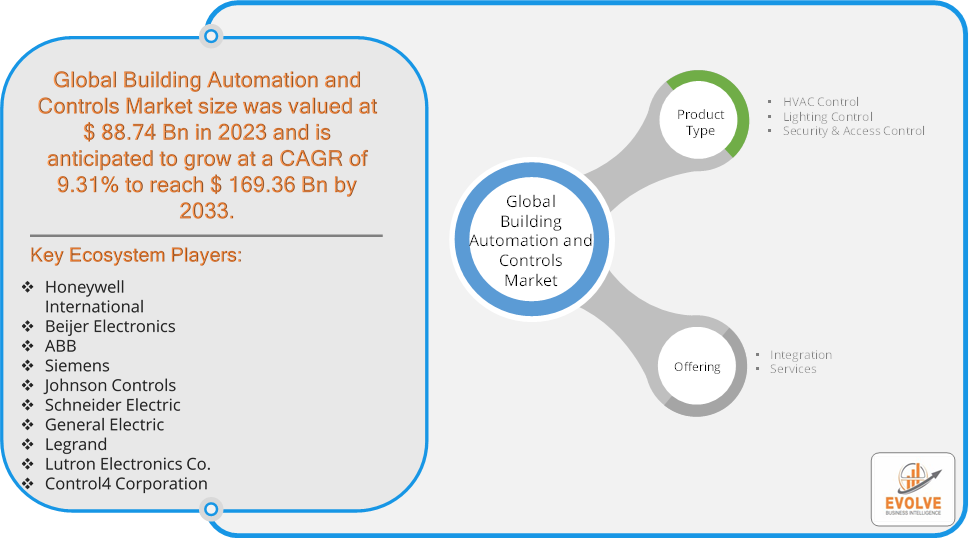Evolve Business Intelligence has published a research report on the Global Building Automation and Controls Market, 2023–2033. The global Building Automation and Controls Market is projected to exhibit a CAGR of around 12.04% during the forecast period of 2023 to 2033.
Evolve Business Intelligence has recognized the following companies as the key players in the global Building Automation and Controls Market: Honeywell International, Beijer Electronics, ABB, Siemens, Johnson Controls, Schneider Electric, General Electric, Legrand, Lutron Electronics Co. and Control4 Corporation.
 More Information: https://evolvebi.com/report/building-automation-and-controls-market-analysis/
More Information: https://evolvebi.com/report/building-automation-and-controls-market-analysis/
Market Highlights
The Global Building Automation and Controls Market is projected to be valued at USD 169.36 Billion by 2033, recording a CAGR of around 12.04% during the forecast period. The Building Automation and Controls Market refers to the industry involved in the development, production, and implementation of systems and technologies designed to control and automate various functions within buildings. These systems are intended to improve the efficiency, security, comfort, and sustainability of buildings by managing and optimizing different aspects such as heating, ventilation, air conditioning (HVAC), lighting, security, and energy management.
The market for building automation and controls is driven by several factors, including the increasing focus on energy efficiency, the growing demand for smart buildings, advancements in IoT (Internet of Things) technologies, and stringent government regulations regarding building energy performance.
The COVID-19 pandemic had a significant impact on the Building Automation and Controls Market. The pandemic caused interruptions in the global supply chain, affecting the availability of components and raw materials needed for building automation systems. Many construction and renovation projects were delayed or halted due to lockdowns, labor shortages, and social distancing measures, impacting the demand for building automation and control systems. The pandemic highlighted the importance of indoor air quality, leading to increased demand for advanced HVAC controls that improve ventilation and filtration to reduce the risk of airborne virus transmission. The need for remote building management grew as building operators sought to minimize on-site staff. This accelerated the adoption of IoT-enabled systems that allow for remote monitoring and control of building functions. The pandemic underscored the importance of resilient and sustainable building practices. This has led to increased investment in building automation systems that enhance energy efficiency, reduce environmental impact, and improve overall building resilience.
Segmental Analysis
The global Building Automation and Controls Market has been segmented based on Product Type and Offering.
Based on Product Type, the Building Automation and Controls Market is segmented into HVAC Control, Lighting Control and Security & Access Control. The HVAC Control segment is anticipated to dominate the market.
Based on Offering, the global Building Automation and Controls Market has been divided into the Integration and Services. The Integration segment is anticipated to dominate the market.
More Information: https://evolvebi.com/report/building-automation-and-controls-market-analysis/
Regional Analysis
The Building Automation and Controls Market is divided into five regions: North America, Europe, Asia-Pacific, South America, and the Middle East, & Africa. North America is one of the mature markets for building automation and controls, driven by stringent energy efficiency regulations, high adoption of smart building technologies, and a robust infrastructure sector. The region leads in the adoption of advanced IoT, AI, and cloud computing technologies, enhancing the capabilities of building automation systems. Europe has stringent regulations promoting energy efficiency and environmental sustainability in buildings, fostering a strong market for building automation and controls. Cities across Europe are investing in smart city infrastructure, integrating building automation with urban management systems to optimize resource use and enhance livability. Asia Pacific experiences rapid urbanization, driving demand for new construction and retrofitting of existing buildings with modern automation technologies. Countries like China and India are significant growth markets due to increasing investments in infrastructure, rising middle-class population, and adoption of IoT-enabled solutions. In Latin America region, Infrastructure development in urban centers is expanding the market for building automation and controls, particularly in commercial and residential sectors. Growing awareness of energy efficiency and environmental impact drives adoption of automation technologies, supported by government incentives and green building certifications. In Middle East and Africa region, Urbanization and construction boom in major cities drive demand for building automation systems to improve energy efficiency and operational management. Governments are increasingly focusing on sustainability and energy conservation, promoting the adoption of automation technologies in new and existing buildings.